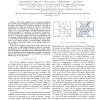Free Online Productivity Tools
i2Speak
i2Symbol
i2OCR
iTex2Img
iWeb2Print
iWeb2Shot
i2Type
iPdf2Split
iPdf2Merge
i2Bopomofo
i2Arabic
i2Style
i2Image
i2PDF
iLatex2Rtf
Sci2ools
ICDE
2010
IEEE
2010
IEEE
UV-Diagram: A Voronoi Diagram for Uncertain Data
The Voronoi diagram is an important technique for answering nearest-neighbor queries for spatial databases. In this paper, we study how the Voronoi diagram can be used on uncertain data, which are inherent in scientific and business applications. In particular, we propose the Uncertain-Voronoi Diagram (or UV-diagram in short). Conceptually, the data space is divided into distinct "UV-partitions", where each UV-partition P is associated with a set S of objects; any point q located in P has the set S as its nearest neighbor with non-zero probabilities. The UV-diagram facilitates queries that inquire objects for having non-zero chances of being the nearest neighbor of a given query point. It also allows analysis of nearest neighbor information, e.g., finding out how many objects are the nearest neighbors in a given area. However, a UV-diagram requires exponential construction and storage costs. To tackle these problems, we devise an alternative representation for UV-partitions, ...
| Added | 20 Dec 2009 |
| Updated | 03 Jan 2010 |
| Type | Conference |
| Year | 2010 |
| Where | ICDE |
| Authors | Reynold Cheng, Xike Xie, Man Lung Yiu, Jinchuan Chen, Liwen Sun |
Comments (0)

